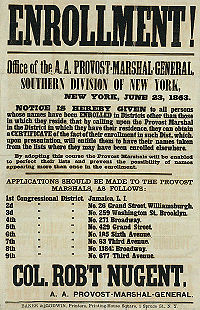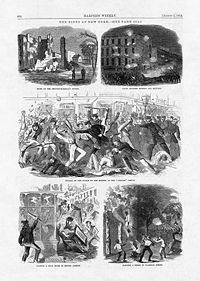| wiki | search |
Main Page | Groups and Assignments | Bios | History | Harlem | Diversity Today | Help
Colonial | Early American | Modern America
The Draft Riots, Black Victimization, and Black Flight, 1863
Background of the Draft Riots:With the second great wave of immigrants pouring in, especially of those of Irish origin, the already fragile position of African American in New York, became even more insecure. Competition rapidly increased for everything from jobs to housing and eventually leading to bitterness that quickly divided the society lowest classes. In the background Civil War raged on, with union defeats such the bloody battle of Gettysburg headlining the newspapers. To increase support and to raise troops for the already unpopular war, Lincoln issued the Emancipation Proclamation followed later that year by the Enrollment Act of Conscription. The Conscription Act allowed the government draft men to fight for freedom that the Emancipation Proclamation promised to the slaves. The act exempted from the draft those who could pay a “commutation fee” of $300. Poor and angry, the Irish saw the act as a way of government to force young Irish men to fight to free Black slaves.
The Draft Riots and Black Victimization:As the first names were pulled from the lottery on Saturday July 11, everything remained calm and peaceful and without forecast of a riot. On Monday the 13th, when the names of the drafted men were published in the newspapers, a sporadic and angry mob formed and filled the city streets. At first the targets were the draft offices and other official and elite institutions. Soon, however, the focus shifted to hatred for the Blacks as the mob attacked all Black institutions and Black sympathizers. Amongst the Black institutions attacked was the Colored Orphan Asylum on Fifth Avenue. The Asylum was home to 223 children who were forced to flee as the mob used their clothing and bedding to set the building on fire. Black men also became special targets for the mob’s torture. William Jones, for example, was hanged at the docks and then his body was burned. Another man, Wiliam Willams was harpooned by a knife and attacked by stones till his body physically dissolved to a pulp. Yet Another, a coachman named Abraham Franklin was dragged through the streets, hanged, and then dragged by his genitals through the streets. While not as inhumane, black sympathizers and amalgamationists faced similar troubles. Those who tried to interfere on behalf of Blacks during the riots were attacked as well as those who in their daily lives socialized with Blacks. Ironically, the mainstay of the Black population at the time in Five Points remained relatively peaceful as Black and Irish neighbors together fought off any part of the mob.
Black Flight:
Panicked and seeking refuge, Blacks fled the city in mass numbers. Although, the city became more sympathetic to the Black community after the riots, by 1865, only about 10,000 Blacks resided in New York, the lowest recorded number since 1820. While some moved to other parts of the state, others left it entirely. Among those who fled, were the influential few, such as James Pennington, who emerged as a community leader after the riots. He urged the U.S. government to allow Blacks to enlist in the civil war while working to insure that constitutional freedoms are guaranteed to the free Blacks.


